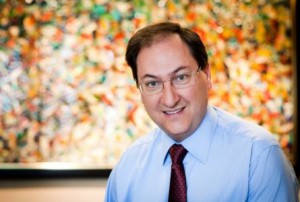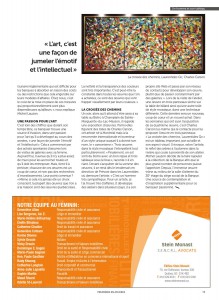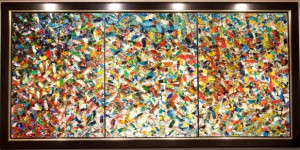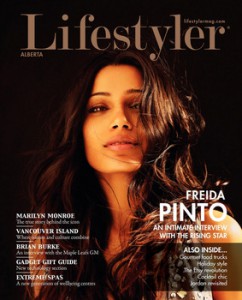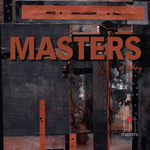Livres & Magazines
now browsing by category
Livres
TRENDS – 121 Contemporary Artists – Charles Carson, reference : pages 96
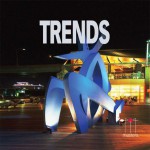
Banque LAURENTIENNE DU CANADA, Michel Lauzon décide de la faire rajouter à la collection de la Banque, une oeuvre importante du grand maître Charles Carson.
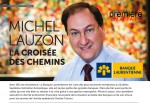
COLLECTION : BANQUE LAURENTIENNE DU CANADA
Michel Lauzon, chef de la direction financière, Banque laurentienne
«L’art, c’est une façon de jumeler l’émotif et l’intellectuel»
Par Marine Thomas
Avec 165 ans d’existence, La Banque Laurentienne est l’une des plus anciennes entreprises au Québec. Septième institution domestique, elle est la plus petite des grandes banques. Mais elle fait aussi partie de celles qui ont très bien su résister à la crise grâce à une gestion exemplaire. Michel Lauzon, vice-président exécutif et chef de la direction financière nous parle de la situation actuelle des banques et de son amour pour les œuvres de l’artiste québécois, Charles Carson.
Lorsque Michel Lauzon entre à la Banque Laurentienne pour la première fois, il n’est qu’un étudiant qui travaille à temps partiel dans les succursales. Après avoir obtenu son diplôme en économie de l’Université de Montréal, il travaille un temps à la Banque Royale comme économiste junior puis en planification financière avant de retourner à la Banque Laurentienne en tant que contrôleur corporatif à la fin des années quatre-vingt. Il y explorera différents secteurs, du marketing à la gestion de produits, de la salle des marchés à la trésorerie. S’il quitte la Banque en 1997 pour aller gérer les finances de TAL Gestion globale d’actifs, il y reviendra de nouveau en 2009, cette fois comme vice-président exécutif et chef de la direction financière. Depuis, il chapeaute deux grands secteurs de la banque, la finance et la trésorerie corporative.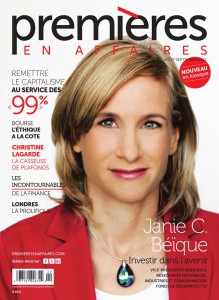
Moins internationale et moins dans les marchés des capitaux, la Banque Laurentienne a bien su résister à la crise de 2008. « La Banque a toujours eu un caractère un peu plus conservateur que les autres. Nous avons comme ligne de conduite que si on ne comprend pas le domaine d’affaires dans lequel on veut se lancer, il vaut mieux s’abstenir. En gardant le focus sur notre plan d’affaires, on a réussi à passer à travers la crise avec des bons résultats, à augmenter graduellement les dividendes pour nos actionnaires et à rattraper nos concurrents en termes de rentabilité malgré le déficit de taille. »
En effet, avec une croissance annuelle moyenne de son chiffre d’affaires de 10 %, elle est aussi l’une des seules banques d’Amérique du Nord à avoir augmenté son dividende chaque année depuis six ans, avec un rendement de l’avoir des actionnaires entre 10 à 13 %. « Même si ce n’est jamais spectaculaire comme augmentation, ce sont des montants par incréments réguliers. Chaque année, on en rajoute un peu, on monte la barre et on parvient à atteindre nos objectifs. C’est ce que les investisseurs ont appris à reconnaître chez nous. Ils apprécient ce manque de volatilité au niveau de nos résultats malgré un environnement qui, année après année, demeure toujours changeant. »
Bâle III
Car le secteur bancaire cherche encore ses marques après le séisme qui a secoué la planète finance en 2008. « Il y a eu certains excès dans certains marchés et dans certaines banques. Or, le milieu bancaire repose sur la confiance des gens. Dès qu’on ébranle cette confiance-là, cela a un impact important, non seulement sur l’institution qui est fautive, mais sur l’ensemble des institutions qui opèrent sur le même marché. »
Heureusement, les banques canadiennes ont su tirer leur épingle du jeu. Si aux États-Unis, 156 banques ont fait faillite, le Canada en compte zéro. Le Canada est également devenu un pays refuge pour certains investisseurs grâce à la bonne tenue de son économie et une dette gouvernementale sous contrôle. Malgré tout, les effets de l’après-crise se font encore sentir et ont amené leur lot de réflexions au niveau des instances gouvernementales et réglementaires mondiales. Dès 2013, une série de mesures regroupées sous le nom de Bâle III seront imposées aux banques. Si elles devaient permettre de créer les conditions de la stabilité financière mondiale, elles risquent aussi de bouleverser les plans d’affaires de nombreuses banques.
« Prises individuellement, toutes ces réglementations ont leurs raisons d’être et sont tout à fait raisonnables. Mais lorsqu’on commence à les cumuler, on crée un tsunami réglementaire qui est difficile pour les banques à absorber en raison des coûts ou des restrictions que cela engendre sur leurs modèles d’affaires. Chez nous, c’est le coût de la mise en place de ces mesures qui proportionnellement sont plus dispendieuses qu’ailleurs. », nous explique Michel Lauzon.
C’est loin des chiffres que durant son temps libre, ce banquier trouve une source d’évasion dans une passion pour l’art qu’il a développé au cours des années, « une façon de jumeler l’émotif et l’intellectuel ». Cela a commencé par des achats spontanés d’œuvres lors de visites de galeries avec sa femme. Aujourd’hui, il avoue qu’il n’y a plus assez de murs pour les accrocher toutes et qu’il doit les entreposer. Mais, tient-il à préciser, chacune de ces œuvres est un coup de cœur, et non pas des recherches d’investissements. Leur point commun ? « Même si cela n’a jamais été un choix conscient, la plupart des œuvres que l’on a à la maison sont des œuvres québécoises. La netteté et la transparence des couleurs sont très importantes. C’est peut-être la constante dans toutes les œuvres que l’on a achetées, ce sont des œuvres qui vont frapper visuellement par leurs couleurs. »
La croisée des chemins
Un soir, alors qu’il attend d’être assis à sa table au Bistro à Champlain de Sainte-Marguerite-du-Lac-Masson, il regarde une exposition d’œuvres. Parmi elles figurent des toiles de Charles Carson, cet artiste né à Montréal, mais à la renommée internationale et inventeur d’un style unique auquel il a donné son nom, le « carsonisme ». Trois œuvres dans le style mosaïque l’interpellent tout particulièrement. « Finalement, on est sorti du bistro avec un bon repas et trois tableaux sous le bras », raconte-t-il en riant.
Devant s’acquitter de la somme des œuvres, il se rend dès le lendemain en direction de Prévost dans les Laurentides où demeure l’artiste. « C’est un homme très sympathique. Pour un artiste, je l’ai trouvé très d’affaires. Il développe des ateliers dans plusieurs pays, il a son propre site Web et passe par son réseau de contacts pour développer son œuvre, plutôt que de passer constamment par des galeries. ».
Lors de la visite de l’atelier, une œuvre en trois panneaux sèche sur la table de billard ainsi qu’une autre toile de style mosaïque, dans une technique différente. Cette dernière sera un nouveau coup de cœur et un nouvel achat. Dans les semaines qui ont suivi l’acquisition de sa quatrième œuvre, c’est Charles Carson lui-même qui le contacte pour lui proposer l’œuvre en trois panneaux. « La croisée des chemins, Laurentides Qc » est un tableau important, par sa taille et son aspect visuel. Il évoque, selon l’artiste, le reflet des arbres à l’automne dans la rivière qui coule à proximité de son atelier.
Michel Lauzon décide de la faire rajouter à la collection de la Banque afin que le plus grand nombre de personnes puisse l’apprécier. Depuis, l’immense œuvre trône au milieu de la salle d’attente du 20e étage du siège social de la Banque. Une source de contemplation et d’inspiration supplémentaire pour ce banquier passionné.
Article paru dans le numéro août-septembre 2012, spécial Finance
http://www.youtube.com/watch?v=o3gXf7DiPlA
http://www.youtube.com/watch?v=AnVuYf-PI_8
COLLECTIONS CORPORATIVES ET PUBLICS :
| Banque Laurentienne du Canada
Laurentian Bank, Mc Gill College Caisse Desjardins, Édifice Riopelle, Mtl. Guess Marciano Inc (George Marciano) LHôtel, Vieux-Montréal Domaine Nudant, France Bistro à Champlain Dr. Champlain Charest Dr. Michel Langevin Golf Griffon des Sources Investissement Elmag Inc Placement Martin Valois Inc Me. Michel Trudel Inc Canadian Tire Dealers’ Association Conseils international, Montréal Services Immobiliers Trustcan Inc Gilles Desjardins Inc Yves Létourneau, USA (Chanteur) Boening Fine Arts, Francfort, Allemagne Arte Autopista, Medellin Dr. Hildebrando Mejia Persol Holdings inc. Sydney & Levitsky Consultants inc Services Financier Isabelle Inc. Énergie Cardio Inc Concept ga Inc Emballuxe Inc Dr. Claude Mercier Inter Groupe Assurances Habitation Trigone 2000 Groupe Michel Desjardins Transcontinental inc Aéroportuaire, Colombie Église Santo Domingo, Colombie
|
Hôtel Dann Carlton, MedellinBill Clinton, ex-prés, États-Unis
Remax-Hometown, États-Unis Gestion R. Brodeur Inc. Ambassade du Vénézuela, Colombie The Pollard Art Gallery, Montana Industria, Medellin Artopale Inc Bérubé Inc, Ottawa Blais & Parent, Québec Broker Sanchez, USA Ciné-Lande, Québec Chlorophylle, Québec Collège Jean Eude, Québec École des beaux-arts, Colombie Fourniture de Bureau Denis, Mtl Hôtel Laureles 70, Colombie Hôtel Dann Carlton, Medellin L’Aventurier, Québec Katona Inc, Vancouver Bi-Op, Inc, Joliette Larkin’s Swindon, UK Outils Gladu Inc, Québec Me. L. Léger Dr. Michel Poisson Dr. Morissette Dr. R. Henry Juge Jacques Coderre Me. Michel Arseneau Me. L. Raymond Clinique Dr. Bergeron Dr. Gagnon Dr. M. Doyon |
GALLERY FOCUS: INGLEWOOD FINE ARTS – MASTER CARSON

LIFESTYLER MAGAZINE
GALLERY FOCUS: INGLEWOOD FINE ARTS
By Veronica Boodhan on December, 12 2011
– See more at: http://www.lifestylermag.com/culture/gallery-focus-inglewood-fine-arts#sthash.AgrdbKN3.dpuf
From the time he was just 14 years old, Charles Carson’s passion for visual art inspired him to connect with audiences on as deep a level as possible. Acknowledging that abstract art does not always appeal to everyone, he strove to make it more accessible.
“To me, artistic expression is so much more than a trite gesture or a red dot on a black background. An artist who has something to say must surpass and reinvent himself,” says Carson. “My profound desire is to bequeath a body of work that resonates with future generations.”
During his time as an emerging artist in his hometown of Montreal, his artistic heroes included Renaissance greats Leonardo de Vinci and Michelangelo, as well as the modern masters Turner and Matisse, all of whom Carson says “devoted their lives to the pursuit of excellence and whose art continues to move people generations after their passing. Their genius is a constant source of inspiration.”
However, it was after residing in South America for 10 years that Carson began developing his true inspiration for his groundbreaking art — the environment.
“Art should not only capture the beauty of the environment but instill a desire in others to preserve that beauty. I am very sensitive to ecological and environmental issues and for this reason, my subject matter is mostly derived from nature. Nature is the source of my inspiration and I strive to represent it in different forms transformed by the mind’s eye,” he explains. “Through my paintings, I try to create a space where the artist and viewer meet and lose themselves, a vehicle for communication, communion, a living work.”
Carson has had a highly influential role in the art world, creating Carsonism, a term coined in 1992 by art historians including Louis Bruens, co-founder of Académie Internationale des Beaux-Arts du Québec (AIBAQ), for his expressive art technique that surpassed the traditional categories of impressionism, expressionism and surrealism. In 2007, he was inducted into the AIBAQas “Master of Fine Arts,” and has been the recipient of numerous prestigious awards including Artist of the Year at the Montreal Museum of Fine Arts Academia XXI Gala in 2009. His list of high-profile collectors includes Bill Clinton.
“I was determined to not offer my work for sale until I had achieved my goal of creating a new pictorial language without any direct resemblance to an existing style or technique,” he says in describing the creation of the Carsonism movement. “This gave rise to many years of disciplined research and experimentation to create and develop the pictorial language to which I have become identified and that is marked by its use of vivid colours, luminosity and spontaneity.”
Carson is featured in a permanent exhibition at Inglewood Fine Arts, where more than 40 of the artist’s works showcasing the Carsonism movement and mosaic movement can be viewed. Located in Calgary, the gallery focuses on spotlighting a select few artists in an effort to give visitors a more enjoyable visual experience.
Carson’s close friendship with Michel Arseneau, owner and director of Inglewood Fine Arts, began over 20 years ago when Arseneau was pursuing his professional career in Montréal.
“Michel purchased one of my paintings through my agent at the time while I was still living in South America. We met shortly thereafter during one of my trips to Montreal and kept in touch over the years, sharing our passion for art,” says Carson. “His recent relocation to Calgary provided an ideal occasion for him to become my representative there and introduce my work to the evolving art market of Western Canada.”
» inglewoodfinearts.com•
Photo Courtesy: Inglewood Fine Arts – See more at: http://www.lifestylermag.com/culture/gallery-focus-inglewood-fine-arts
Fine Art Magazine – Fall 2009 – USA
Fine Art Magazine – Fall 2009 – USA Carson, page, 5,6,7 Charles Carson at The Montreal Museum of Fine Arts — Gala ACADEMIA XXI — where he was honored as Artist of the Year “Charles Carson shows each and every unique feature of his great poetic skills, offering in his work a breath of life, his own life. Proof that Carson has worked his way toward artistic posterity came on the day that we started saying ‘It’s a Carson’ in the same way that we proclaim ‘It’s a Picasso, a Matisse,a Warhol,a Basquiat’or any other immortal artist.’’ —Christian Sorriano, Fine Art and Antiquities expert. This is “Carsonism…” By VICTOR FORBES Riding the bone-chilling north wind into New York City on his 2009 world tour, Charles The Spring Edition of Fine Art, featured Heroes of Creativity, Mr. Carson on the cover with a clever headline, “Carson to the ism.” Several Art historians around the world and museologist have deemed his style Carsonism,and his intricate and highly original works are as punctual and directed as the artist himself. These are strong paintings in two distinct yet related styles. The dimensional mosaic paintings with a build up of the paint and then glazed combine logically and intricately to give the appearance of a polished sea of possibility, glimmering mirror-like in a bath of pristine luminosity. |
Christian Sorriano, Fine Art and Antiquities expert from Paris and President of Drouot Cotation, “Art holds no more secrets or mysteries for a matured expert like myself. … Far from common trends and cheap visual effects, Charles Carson shows each and every unique feature of his great poetic skills, offering in his work a breath of life, his own life, therefore questioning and delighting the minds and the trained eyes of the connoisseurs who hang it on the walls of their daily lives.” Over many years, said Fine Art publisher Jamie Ellin Forbes, “We’ve had the privilege of meeting so many artists. Some have risen to great acclaim and importance while others have fallen to the wayside. Each brings his or her own need to communicate their own dreamscape to the viewer and if you talk about this either in print or in person, you never know who you are going to be inspiring, what window you are going to open in their souls to communicate to the next level. The artist does this and such work is very important in all cultures. During this period of time, when people redefine values, they will find it much more so. Artists will become more important than they have been in the last ten or fifteen years outside of certain collectible concerns. Charles Carson’s paintings have a unique language. They are dreamscapes that invite you into the space, which makes you a part of the process of whatever the moment is that the artist is describing. It’s not a snap shot. You are invited into the imagination of the process and somewhere there’s been an instigation or an inspiration involving the colors, the mystique. The line is defined through the paintings with the application of the form married through the colors defining the lines. The painting itself—the composition—therefore becomes very free, very available for people to enter into.” |
“Because the colors are incredibly clean, there’s a tempo. You can’t just paint and you can’t extra-polate unless you know form; you have to know form, you have to be able to paint in order to extrapolate. Carson applies the paint with a tempo and a sense of color as if the light were coming through. The pieces are very energetic, almost kinetic—and there’s a definite form lent through the application of the color. I don’t know what Mr. Carson has in his mentality as he paints, but it looks to me as if he’s painting the subconscious vision of what he sees; that he steps into the space between space, the dream space—and starts to paint the colors as they vibrate, as one form transitions from dream to reality and reality to dream and the abstract in-between. The colors are incredibly clean, which is rare—and they are built, have definition and are textural. You would think that it’s simple, but it is not. This is a very complex and difficult mode of expression to arrive at and you have to have an understanding of harmony and tempo to have a significant balance throughout the piece in order to create the composition. The result is the school of thought Carson is forming—Carsonism, Carson to the ism.” There are elements to this work that I have not seen elsewhere. I have not seen this technique done elsewhere. Have you? “Isn’t this the founding of a thought process or a school? Did anybody do Braque or Leger, or Pollock before they did themselves?” |
Fine Art Magazine – Spring 2009 – USA – Page couverture – Charles Carson – Heroes of creativity
Fine Art Magazine – Spring 2009 – USA Charles Carson « Heroes of creativity » CARSON TO THE ISM By Jamie Ellin Forbes & Victor Bennett Forbes Charles Carson has embraced his chosen mode of expression with the passion of a master, the nerve of an adventurer, and the intellect of a historian. Born in Montreal in 1957, he discovered his calling as he approached his teens. Frustrated at an early age with his own futile early attempts at originality, Carson went on a quest to find his vision — to Europe, Asia, the US and South America, living in his own dream fueled by the sea, forests and wildlife and by his lofty personal ideals. Carson was strong, is strong, but somewhere in Colombia, he found that even the strongest river cannot flow uphill. He became infatuated with the world’s fragile beauty; indignant in the face of man’s lack of conscience. It did not take him long to find out that the world was upside down, and when he discovered this, he sought to make it right. His brushstrokes on the canvas are akin to the soaring notes found in the best alto sax solos. May one dare say David Sanborn and John Coltrane in the same breath as Charles Carson?….history will decide that, but in his own time, M. Carson gives a vibrant tip of the hat to the incomparable mystery and uniqueness of life — all of which are reflected in his canvasses. A cool cat painting the world, he’s reached his cruising speed and hit a rhythm he calls “more than hectic. It’s a state of mind that propels me.” Charles Carson, as the innovator of his new pictorial language as motif is credited as father and founder of the art movement entitled “Carsonism.” He is a nature lover and environmentalist who reflects and incorporates his ingenious view, as affirmed universal metaphor, in his personal lens of vision. The artist demonstrates Nature, as filtered through his imagination, deploying a creative extrapolation of evocative image. His works, being widely collected, attest to their appeal. Carson’s auction record at esteemed houses suggest that. He shares his passion on canvas to inspire others to see what he has found in expressing the creative beauty abundantly surrounding all. It would seem that Kandinsky’s words from his immortal little book, The Spiritual in Art, published in 1910 (“The boldness of color in a painting must attract the spectator forcefully and at the same time mask the deeper content.”) left a lasting impression on the young artist. The impact of his colors were developed in Colombia and other tropical vistas, far away from the winter of his youth — those endless nights where different shapes haunted his compositions, giving them a certain presence of dimensionality. In those cold days, he learned to focus on that hidden dynamic which so energizes his work. He paints in movement with a technique and energy appropriated from masterful predecessors. Some would cite Mondrian, Jackson Pollock, van Gogh. Those legendary figures have accomplished everything, but not even Picasso had an art movement named for him, yet we have Carsonism. This term was coined by a noted critic who was quite impressed not only with the work, but with the sheer volume of intense paintings produced by the one young man. Lise Grondines, art historian and graduate of the Paris Académie française des sciences et des lettres, past president of the Salon International des Beaux-Arts de Montréal in 2002 told the artist “Carsonism places you among avant-garde leaders on the Canadian and international art scene and can be considered key in global abstract contemporary art. Your paintings are refreshing, strongly executed and demonstrate a rare expression.” Carson’s travels were the impetus for his deeply affected feelings regarding the social and ecological problems of today’s societies. Nature is now occupying a primary place in his creations, one of the major turning points in his work. His tropical scenes combine colors usually associated with a Caribbean sunset, yet he produces even greater depth and power than would seem conceivable from the paint. What technique manages to get such verve from color, and yet such detail? Again, it can only be described as “Carsonism.” |
Charles Carson – MASTERS OF TODAY – World of Art, – London
(Version anglais seulement) MASTERS OF TODAY 100 Contemporary Artists Masters of Today is an overview of contemporary art, an invaluable resource book for artists, galleries, museums, dealers, art collectors, who seek the latest trends in the art world. Masters of Today is a graphic creation itself and source of information including over hundred profiles of artists, reporting on the art, personalities and art trends that shape today art world. Distribution provided through eCommerce and large bookstores available in US and Internationally including Amazon, Barnes & Noble, Borders, Powell’s, Alibis, Book-A-Million, Buy.com, Wal-Mart, Ecampus, Textbook, Blackwell, also in Canada, France, Germany, Great Britain, Australia, Japan, New Zealand and many others. Editor and Publisher PETRU A. RUSSU |
Charles Carson Charles Carson concentrates on the essentials of structure, the purity of forms, the transparency and vividness of colors. He paints with complete assurance and focuses on different studies involving color and aesthetics. The work Charles Carson is doing can be clearly distinguished from that of a Riopelle as it takes us to the border lying between the abstract and the figurative (…) In so doing we are able to avoid the old quarrel that has so often arisen between them; indeed it might be said that, with Carson, reconciliation takes place. Carson, slicing like a blade to the core of the matter, launches himself onto each blank canvas via the rapid and nervous dance of his hand, using layered touches nearly always on the diagonal or in wide ellipses. |
From this way of doing things, à la Carson, ‘’comes an impression of such freshness, such dynamism, and what rhythm (…)!’’ that a new – ism, is of necessity required by art experts. Hence Carsonism! It’s more because he is so unclassifiable to begin with, so unique is his form of writing. (He) gives each painting an extraordinary depth that is much more fascinating than the most masterful system of perspective. The impression of freshness and energy we find in Carson’s paintings comes in part from the brightness and purity of the colours, harmonized in a rhythmic and airy juxtaposition by patches of white. The placement of broad strokes (…) seems to be raised up by some mysterious breath, discreet yet efficacious, animating the whole composition. I have been maintaining since 1992 that Charles Carson has developed a truly novel way of interpreting Nature and its creatures in a style that conforms to the principles of aesthetics in terms of the subjects of his compositions and his chromatic resonance. World of Art/WOA World of Art /MOT |
Magazin’art édition internationale, Automne 2006, No, 73
Magazin’art édition internationale, Grande rencontre des artistes le dimanche 5 novembre 2006 Artiste présents; Charles Carson, Natalia charapova, Yvette Froment, Hélène Jarry, Luce Lamoureux, Yvon Lemieux, Pei Yang, Étienne Coté, Marie andrée Leblond, Gilles Bédard. Un évènement à ne pas manquer. |
Charles Carson, Grand Maître de l’Art Contemporain Membre du jury officiel de AEAF et AIBAQ Paris – 2006, Médaillé du Salon international de l’Académie Européenne des Arts France, en reconnaissance de son talent exceptionnel. «Carson est un novateur, de renommée internationale. Oeuvre lumineuse, onirique, tonique, une mosaïque de couleurs dans lesquelles des formes vivantes se déplacent à travers d’autres formes, un entrelacs de couleurs baignant dans des superpositions habiles et des transparences subtiles, le tout balayé par des touches obliques accentuant l’effet de mouvement.» Mme Anne Marie Laurès, Présidente de (AEAF) Soirée ACADÉMIA XXI – Musée des beaux-arts de Montréal – samedi 4 novembre 2006 Charles Carson, membre du jury de l’Académie Internationale des Beaux-Arts du Québec |
«L’Art de peindre est d’oublier la matière, cette dernière n’existe pas…elle n’est plus qu’ombres, lumières et couleurs aux reflets multiples.» Charles Carson Charles Carson est représenté en permanence à la : Galerie d’art Richelieu inc. |
| Charles carson, est aussi représenté en Europe, aux États-unis et en Amérique du Sud |
Magazine PRESTIGE
|
Magazine Prestige Femme de tête et de Passion Par Jean Frenette / Photos: Frédéric Lavoie «Réunissant plus d’une centaine de femmes de tête et de passion, le premier souper gala de la femme de Prestige s’est avéré un succès retentissant.» Mmes Claudette et Sophie Beauchamp, des Galeries d’art Beauchamp, ont encore une fois embelli un intérieur en offrant une oeuvres de Charles Carson, peintre de renommée internationale. Réalisée pour cette soirée, la toile intitulée 100 fois bravo! est d’une valeur de 4000$. Mme Lynda Porter, propriétaire du Buffet du passant – traiteur, aura le loisir de l’admirer tous les jours.» |
|
«Les femmes d’affaires présentes en ont grandement profité pour partager leur passion entre elles, en se laissant gâter tant par le menu concocté par les chefs du 47 ième Parallèle que par les nombreux prix qui furent attribués par tirage. C’est évidemment au cours de cette soirée que fut dévoilé le nom de la femme de Prestige 2006, nulle autre que Mme Andrée Boucher, mairesse de Québec.» La Femme de Prestige 2006: Andrée P. Boucher, |
Première femme élue à la mairie de Québec, Mme Andrée P. Boucher est aussi devenue la première lauréate du titre Femme de Prestige, concours organisé par le magazine PRESTIGE en collaboration avec le 93,3, le restaurant le 47 ième Parallèle et Forge-G comminication. Un honneur qui lui est rendu à la suite d’un vote populaire tenu cet automne. Mairesse de Sainte-Foy, de 1985 à 2001, candidate défaite aux premières élections municipales de la «nouvelles Ville» de Québec, en 2001, Mme Andrée Boucher devient animatrice au 93,3 avant d’effectuer un retour en politique en 2005, remportant une victoire éclatante. Et un an plus tard, sa popularité ne se dément pas. «C’est incroyable…Ça fait toujours plaisir de recevoir un pareil honeur, confie Mme Boucher en apprenant qu’elle a été élue Femme de Prestige 2006. C’est un soutien dans notre travail, ça nous porte. Et à mon âge, ce n’est plus une question d’égo!» Lors du souper gala, Mme Boucher a souligné que toutes les femmes présentes auraient ausi mérité ce titre. «Ça prend du courage pour réussir comme vous le faites. Mais si je peu me permettre un conseil de »grand-mère », gardez toujours un équilibre entre votre vie professionnelle et votre vie personnelle», a rappelé Mme Boucher.» |
Maître Carson, son cheminement, ses découvertes, son audace et sa réussite!
Magazin’art ÉTÉSUMMER 2005, no 68 Reportage sur l’artiste Charles Carson. Louis Bruens Charles Carson,(AEAF) Son cheminement, ses découvertes, son audace et sa réussite! J’ai connu cet artiste peintre alors qu’il s’escrimait en vain à reproduire les éclairs et les formes projetés par son imagination. Il n’avait pas encore trente ans. Je le voyais déterminé, tenace, volontaire, pour ne pas dire obstiné, mais, comme tant d’autodidactes à leur début, ses résultats sur la toile étaient bien mièvres, sauf son sens évident des couleurs. Des tableaux, j’en ai vus dans ma carrière, j’en ai analysés, décomposés, comparés et, généralement, je pouvais facilement découvrir les défauts et les qualités de chacun, mais les tableaux de Charles Carson, de cette époque, étaient, à mes yeux, plutôt mauvais … et pourtant, ils me fascinaient par un détail que je ne pouvais définir. Je pense que c’était son sens inné de la couleur. Son écriture picturale était un ensemble de formes… sans formes. Pourtant, quelque chose d’indéfini émanait de son « peinturlurage », quelque chose que je ne pouvais élucider et qui m’intriguait. À chacune de nos rencontres, il me demandait s’il était prêt à entrer sur le marché de la peinture ; ma réponse était chaque fois la même : « NON ! Tu vas te casser la figure avant même de commencer ». Ce petit jeu a duré plusieurs années au cours desquelles il continuait à s’acharner courageusement, parfois péniblement, à jeter ses couleurs sur la toile, espérant, à chacune de nos rencontres, d’entendre mon verdict : OUI, TU ES PRÊT! Et il me quittait, triste et amer, après avoir avalé mon refus de lui mentir en l’encourageant à prendre le chemin de l’insuccès. Au cours de toutes ses années, il a accepté mes conseils, mon analyse et… mes refus. Il lui a fallu une fameuse confiance en moi et surtout beaucoup de courage pour persévérer, pour poursuivre son rêve: Il aurait pu ne rien écouter, il aurait pu, comme tant de jeunes artistes, visiter les galeries, il aurait pu oublier ses explorations, ses expériences picturales, surtout, il aurait pu abandonner devant le peu d’encouragement de son entourage. Mais non ! Il n’a jamais accepté la défaite. Charles Carson est un battant naturel. |
Tu es prêt, vas-y, fonce ! Par la suite, nous ne nous sommes plus vus durant quelques temps. Un beau matin, il y a de cela près de quinze ans, il arrive chez moi, un tableau dans les mains, un petit 51 X 41cm, intitulé l’Envol. Il le déballe lentement, avec hésitation et… cette fois là, j’ai été stupéfait. Ce tableau était une petite merveille. Un semi-figuratif aux couleurs éclatantes, une composition qui répond parfaitement aux règles de l’art dans un ensemble étonnant d’imagination. Charles, tendu, m’observait sans dire mot ; il attendait mon verdict. Quel bonheur nous a tour à tour envahi alors que j’ai prononcé ces mots : « C’est merveilleux ! Tu es prêt, vas-y, fonce.» Les tableaux qui ont suivi ont forcé mon admiration. Suite à quoi, quelques temps plus tard, j’écrivais la toute première analyse de la création picturale de Charles Carson pour le C.I.D.I.AC. Je lui ai dit cette fois là : « Tu viens de créer un nouvel «isme», mon garçon ». «Le fondateur du musée d’Art Contemporain Nous n’étions pas nombreux en qualité d’historiens et experts indépendants à cette époque. Il y avait, en dehors de moi-même, mon ami, historien et fondateur du Musée d’Art contemporain de Montréal, le regretté Guy Robert et, Jacques de Roussan, critique d’art, aussi disparu aujourd’hui. Très rapidement, Guy Robert s’est rattaché à mon avis en écrivant, à son tour une excellente étude descriptive de la peinture de Carson, publiée par les Éditions Ikonia Extrait de son analyse: «Carson donne au tableau une profondeur particulière plus fascinante que la plus habile maîtrise des système les plus savants de perspective» «Hélas,ou plutôt bien heureusement, aucune étiquette des -ismes- bien connus dans la pagaille de l’art contemporain ne semble pouvoir y adhérer, et je devrai donc en parfaite accord avec mon ami Bruens me résigner, d’ailleurs avec grand soulagement, à nommer ce style : le carsonisme!». Jacques de Roussan, en qualité de critique, a rejoint nos avis en ajoutant une vision tout aussi personnelle de l’art de Carson. |
FUSION et PASSION Le Carsonisme: une réalité… « Nul n’est prophète en son pays » Ce coloriste a ressenti le besoin de renouveler sa palette, de voir de nouveaux espaces, des lumières différentes; les couleurs inconnues lui sont encore et toujours nécessaires. Il ira vivre quelques années en Amérique du Sud et particulièrement en Colombie son pays d’adoption. Il y a fait couler beaucoup d’encre, tant au sens propre qu’au sens figuré ; à tel point qu’en 1997, pour souligner son apport à la culture Colombienne. La Société aéroportuaire lui a rendu hommage: une statue en bronze grandeur nature à son effigie a été érigée dans la ville de Carthagène. L’artiste a aussi signé une murale monumentale intitulée: El cabbalo de mar, elle orne le hall de l’aéroport principal de la ville ainsi qu’une murale de scène religieuse intitulée: Yo hice lo que tú quérías pour l’église Santo Domingo (monument classé patrimoine mondial). Il y a produit aussi de nombreuses et excellentes scènes sous-marines, toujours dans le genre carsonisme. ANECDOTE : Lors d’un voyage en Colombie avec Caroline mon épouse, quel ne fut pas notre étonnement de découvrir à l’aéroport une immense murale, un tableau splendide de Carson, intitulé El Cabbalo de mar. Cet immense tableau de 4 mètres de haut retient immédiatement l’attention des voyageurs car il est situé dans le hall de l’aéroport de Carthagène. Quelques jours plus tard, au cours de nos pérégrinations dans la ville, nous tombons face à face avec quoi ? Un bronze grandeur nature à l’effigie de Charles Carson. Est-il donc à ce point célèbre notre ami Charles ? Nos pas nous conduisirent à visiter la fameuse Église Santo Domingo (monument classé patrimoine mondial) où le très aimable et vieux curé est très fier de nous faire admirer une autre murale religieuse celle-là, intitulée : Yo hice lo que tu quérias. Une autre oeuvre murale du plus pur carsonisme. Mais c’est dans son atelier que nous avons pu admirer les plus beaux fonds marins que l’artiste a produit. Comme quoi « Nul n’est prophète en son pays. Nous étions très fiers de lui et de sa réussite. |
MAÎTRES CANADIENS DE L’ART CONTEMPORAIN Une exploration nouvelle des mosaïques de Carson… À son retour au Québec, en l’an 2000, après une tournée européenne, il entreprend l’étude de l’art abstrait dans ses divers aspects et réussit à innover un nouveau genre de mosaïsme. Il nous faut nous souvenir de Jean-Paul Riopelle et de sa période « mosaïque de 1950-1960 ». Depuis cette époque, aucun artiste n’avait réellement réussi à produire une peinture de qualité de ce style particulier. Charles Carson, par sa recherche d’étude de juxtaposition des couleurs dans une limpidité des plus surprenante a relevé ce défi et, bien que sa technique ne ressemble en rien à celle de Riopelle, elle est d’une égale qualité. En 2004 le critique d’art Robert Bernier, publie un article de 16 pages sur l’œuvre de Carson, dans l’éditions « Parcours » dont voici un extrait :« On dirait un flot incessant de particules qui balaient la matière avec une régularité fascinante, voire déconcertante ». Ensuite, nous découvrons un véritable feu d’artifice de couleurs dans ses œuvres les plus récentes, des tableaux qui ne peuvent que nous étonner et nous ravir. Après avoir récolté plusieurs prix à l’échelle nationale et internationale en 2005, Charles Carson devient membre officiel de l’AEAF (L’Académie Européenne des Arts-France) Naturellement, qui dit succès en peinture dit aussi valeur financière. Un artiste ne peut peindre plus d’un certain nombre de tableaux par année. Si la demande est plus forte que l’offre, comme en bourse, sa « cote » monte au gré de sa réputation et de son succès. C’est le cas de Charles Carson qui se voit aujourd’hui très en demande par les investisseurs. |
SA COTE, SON MARCHÉ CHARLES CARSON, À LA CONQUÊTE DU MARCHÉ EUROPÉEN Les graphiques qui suivent sont assez éloquents. Sources référence; Dictionnaire Drouot cotation 2004 et 2005, Paris.Diffusion par la prestigieuse maison Larousse. Sous la direction de Christian SORRIANO: Expert en ventes publiques Parution: Paris 2004 CARSON né en 1957 24 000 € Profondeur marine acrylique 101 x 152cm Dictionnaire Drouot cotation Paris 2005 Cotations de 2000 € à 85 000 € 45 000 € Vibration Acrylique 160 x 118 cm Nous avons au Québec d’excellents peintres et bon nombre parmi eux pourraient suivre le chemin parcouru par Charles Carson… s’ils ne se satisfaisaient pas de travailler en atelier ou d’être simplement représentés par quelques galeries du Canada… ou encore de compter particulièrement sur leur site Web pour assurer leur réputation ou augmenter la vente de leurs oeuvres. En conclusion, il est conseillé aux amateurs d’art et investisseurs de suivre de près la carrière de Charles Carson. Louis Bruens, écrivain, historien et expert scientifique en analyse d’oeuvre d’art depuis 1960. Lauréat du Grand Prix Gutenberg, 1993,1994 et 1995. Il est le fondateur de l’Académie international des Beaux-Arts du Québec. |
Magazin’art Édition internationale, Printemps 2005, No, 67
Magazin’art édition internationale, 17 ième annéee, Galerie d’Art Richelieu inc. Charles Carson, Maître de l’art contemporain POUR NOTRE CLIENTÈLE NATIONALE ET INTERNATIONALE RECHERCHONS OEUVRES GRANDS FORMATS, STYLE, «MOSAÏQUE» DE L’ARTISTE INTERNATIONAL CHARLES CARSON. PAYONS DE 20 000$ À 50 000$ SELON LA PÉRIODE CONTACTEZ MADAME COLETTE RICHELIEU www.galerierichelieu.com 7903 rue Saint-Denis, Téléphone: (514) 381-2247 Courriel: crichelieu@bellnet.ca Ouvert du mardi au dimanche de 11h à 17h. |


